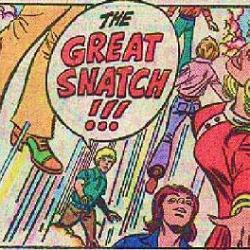Nicolae: The Rise of Antichrist; pp. 315-318
This section of our story would be a terrific set-up for any storyteller who cared about character. Rayford Steele is presiding over the memorial service for the Rev. Bruce Barnes. He’s finished his evangelistic sermon — albeit forgetting to include the actual evangelistic part — and now he opens the floor to anyone who’d like to stand and say a word about their dear departed pastor: “I feel compelled to open the floor to anyone else who feels led to say anything in memory of our dear brother.”
Well, this being Rayford, it takes him a while to get to that. What he actually says is this:
“I would also be remiss if I did not try to share with you at least the core thoughts from the sermon Bruce had prepared for today. It is an important one, one none of us in leadership here would want you to have missed. I can tell you I have been over it many times, and it blesses me each time. But before I do that, I feel compelled to open the floor to anyone else who feels led to say anything in memory of our dear brother.”
I would be remiss not to point out that the phrase “I would be remiss” gets used way too often in this chapter. And I would also be remiss not to note that this throat-clearing phrase almost always signals that it is about to be followed by something both ponderous and vapid — as the example above demonstrates.
But anyway, Rayford invites the congregation to share their stories. This is an opportunity to explore who Bruce really was — to see him through the eyes of the members of this community and, thus, to come to know both him and the rest of this community by hearing a few of their stories about their beloved leader. This could be the Our Town or Spoon River Anthology chapter for this congregation, finally giving us names and faces and stories for its nameless, faceless, unstoried members. Even just one story — just one person other than the little knot of the inner-inner circle standing and sharing a story about Bruce would go a long way to humanizing the members of the church and to making readers feel and understand their sense of loss for the death of their pastor.
But we don’t get that. Not even one story, one name, or one face. Instead, we’re told that people told stories. And we’re told that those stories were moving and inspirational. So I suppose that if we readers could have been there to see those people rise and to hear them tell those stories we might have been moved and inspired ourselves. Alas, we’ll never know. If only we’d had someone there to witness this and to write about it for us.
Throughout this series, Jerry Jenkins provides a graduate-level seminar in how not to write fiction. This scene displays his approach to characterization. For Jenkins, the best way to convey character is to assert it directly in the voice of the narrator: “Rayford is brave.” The next-best approach, for Jenkins, is to have the character state this assertion about themselves: “‘I am brave,’ said Rayford.” And Jenkins likes to supplement those by also having other characters restate this assertion: “‘Rayford is so very brave,’ thought Buck.” And since he has all of these voices asserting this attribute of the character’s character, Jenkins seems to think it would be overkill to add to that by ever showing the character behaving in a way that would match this description.
This is, of course, bass-ackwards and upside-down. It’s the opposite of what any writer should be doing. “Show; don’t tell” is a clichéd slogan from every introductory writing class because it is necessary and good and true. But the only thing Jenkins ever shows us in his storytelling is just why that hoary advice is true. By always telling and never showing, he inadvertently shows us the importance of that rule.
Thus after Rayford “opens the floor” to allow others to share their memories of Bruce, the first person to stand is Loretta — the designated non-Tribulation-Force parishioner and one of the two New Hope church-members whose names our heroes have bothered to learn.* We don’t even get to hear Loretta tell her story. We’re simply told that “Loretta told her now-familiar story,” after which:
Rayford stood listening as people from all over the sanctuary stood and testified to the impact Bruce Barnes had had on their lives. It went on and on and on for more than an hour. Finally, when there seemed to be a lull, Rayford said, “I hate to arbitrarily end this, but if there is anyone else, let me ask you to stand quickly. After one more, then I’ll allow any who need to leave to do so. Staying for my summary of what would have been Bruce’s sermon this morning is optional.”
And then the last person to stand and speak turns out to be Tsion Ben-Judah — who never met Bruce and is not a member of the congregation.
So after setting-up this opportunity to allow readers to learn more about Bruce, more about the members of New Hope church, and more about Buck and Rayford (as we overhear their thoughts in response to those stories), Jenkins just punts. This would have been a great chance to explore and develop character, but these books aren’t about character.
These books are about plot. They are novels “of the Earth’s Last Days” — plot-driven accounts of what Tim LaHaye says the Bible prophesies will happen in the near future.
Describing a story as “plot-driven” oversimplifies the way stories work. We might say for example, in very broad strokes, that an Agatha Christie mystery is mainly about plot, a G.K. Chesterton mystery is mainly about theme, and a Raymond Chandler mystery is mainly about character. But since those are all good writers and good storytellers, their emphasis on one aspect doesn’t exclude the others. A plot-driven story that is well told won’t neglect character or theme. It will develop those elements with great care, ensuring that they serve to advance the plot. A well-told story that may seem more character-driven still requires a plot, but the plot will tend to function to reveal character. And so on.
In any well-told story, these elements will reinforce one another. In a poorly told story — or an abysmally told story, like this one — those elements will undermine and contradict one another. They will seem incompatible or impossible, and the whole thing will become unbelievable.
Such categories and abstractions, again, are an oversimplification. In any well-told story these things are so organically integrated that it’s difficult to distinguish where one begins and another ends. And I’m not sure it’s ever really possible, even in a badly told story, to neglect any of these.
Jerry Jenkins may have no interest in developing his characters and no patience for it, but he’s constantly revealing character despite that — doing so accidentally, unconsciously, and unintentionally. Thus despite the relentless assertion of Buck and Rayford’s virtues in Jenkins’ all-tell, no-show approach, we readers have come to see quite a bit about the actual character of these characters — all of which contradicts Jenkins’ claims about them and their claims about themselves. And despite all the nasty assertions Jenkins tells us about characters he doesn’t want us to like — Hattie, Verna, women in general — what he shows us of their actions leads us to admire those characters in ways he never intended. (Thus my reference in this series to “meta-Hattie” and “meta-Loretta” — the indomitable figures who refuse to be bound by what we are told about them.)
One way or another, characterization happens. It’s unavoidable, even for the worst writers and the worst story-tellers.
The clearest example of L&J’s unintentional characterization contradicting their claims and assertions doesn’t involve any of these human characters. The most fully — if accidentally — developed character in this story is that of God. The authors tell us many things about the character of God. They tell us, and have others tell us, that this character named God is good and loving and righteous, but everything they show the character doing contradicts that. They tell us that God is the real hero of this story and the champion of all that is good. But the God they show us is cruel, capricious, petty, vindictive, and Kafkaesque. LaHaye and Jenkins portray God as one of the most despicable villains of all time.

And just as characterization happens regardless of whether it is intentional, so too theme happens whether or not the storyteller means it to. Themes emerge, bidden or unbidden. And the themes that emerge, much like the characters that emerge, may wind up contradicting whatever theme it was that the authors intended to convey.
LaHaye and Jenkins imagine that this chapter has an evangelistic theme — stressing the importance of the message of salvation. But given what they have revealed to us of the villainous character of “God,” that theme doesn’t come across quite the way they intend. “God,” they have shown us — and will show us even more in the rest of this chapter — is vicious, destructive, and hateful. The meaning of evangelism or salvation thus becomes a matter of getting on the good side of this monstrous villain … or else.
In this framework, evangelism becomes less about an invitation to the good news of the gospel and more like that key moment in many stories — a key moment for character, plot, and theme — when the arch-villain invites the hero to join the side of evil because the side of evil is destined to win. The closest parallel such “evangelism” has to anything in the gospels is the story of Jesus temptation in the wilderness.
– – – – – – – – – – –
* Donnie Moore, the computer guy. Unless I’m forgetting a third person. Is there a third person yet?












